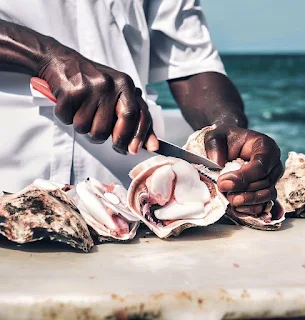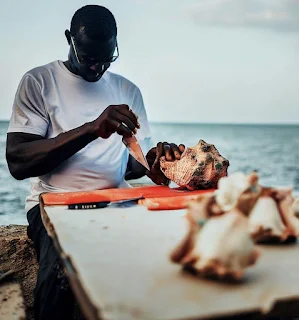Florida and Africa Conch Connection
African cuisine left an enduring impact on the conch loving food culture of Florida.
Conch has a fascinating historical connection with Africa, as it is rooted in the complex narratives of the slave trade and the culinary ingenuity of enslaved Africans.
The conch, a large marine mollusk, is believed to have originated from the shores of West Africa. It was during the transatlantic slave trade that this seafood delicacy made its way to the Florida, serving as a vital source of sustenance for the enslaved population.
Conch is a shellfish. It is a type of large marine snail that belongs to the family of gastropods. Conch shells are typically spiral-shaped and have a distinct appearance with prominent ridges and a pointed tip.
Inside the shell, the conch mollusk resides, and it is this mollusk that is harvested for its meat, which is used in various culinary preparations. Conch is known for its firm texture and sweet flavor, making it a popular ingredient in many seafood dishes.
The conch was an ideal food source for enslaved Africans due to its abundance and affordability. Despite their limited resources and harsh living conditions, the African people drew upon their culinary traditions, resourcefulness, and creativity to transform this humble shellfish into a range of delectable dishes, including conch fritters.
Conch fritters exemplify the profound influence of African cuisine on the food culture on Florida. The enslaved Africans brought with them a wealth of culinary knowledge, which they adapted and merged with the ingredients available in their new environment.
By combining African cooking techniques, such as pounding and grinding, with local Florida ingredients, they created a unique fusion of flavors that would become an integral part of Florida cuisine.
Conch fritters typically involve finely chopping or grinding the conch meat and mixing it with various ingredients like onions, bell peppers, garlic, herbs, and spices.
The resulting mixture is then shaped into small patties or balls and deep-fried to a golden brown. The fritters are crispy on the outside and tender on the inside, offering a delightful combination of textures.
African culinary traditions left an indelible mark on Florida cuisine by introducing conch fritters and other dishes. These gastronomic contributions not only provided sustenance but also served as a form of cultural preservation, allowing enslaved Africans to maintain connections with their homeland and forge new culinary identities in their adopted lands.
Today, conch fritters remain a beloved and iconic dish in Florida, representing the rich tapestry of cultures that have shaped the region. Conch stands as a testament to the resilience, creativity, and cultural heritage of the African diaspora, highlighting the transformative power of food and the enduring legacy of African cuisine in Florida.
Conch has also given rise to several famous sayings and folklores in Florida.
"In the land of conch, the king is a shell." This saying illustrates the importance and abundance of conch in the Florida,. In a place where conch is readily available, it reigns supreme as a prized food item.
Conch shells are often associated with the sound of the sea. In Florida folklore, it is believed that if you hold a conch shell to your ear, you can hear the sounds of the ocean. This belief has become a popular symbol of the sea and coastal living.
In some Florida African, African-American and Caribbean cultures, it is said that blowing into a conch shell can bring good luck or ward off evil spirits. The sound produced by blowing into a conch shell is believed to have a purifying effect and is often used in ceremonial and spiritual practices.
African Slaves Traditional Method of Cooking Conch
In southern Florida, including the Florida Keys and the Everglades region, the labor force consisted of enslaved Africans and their descendants who were engaged in various activities.They worked on plantations, farms, and in industries such as fishing, salt production, and charcoal making.
During the time of slavery in Florida, enslaved Africans and their descendants played a significant role in shaping the culinary traditions of the region. Cooking conch, a popular shellfish found in Florida waters, was a part of their culinary practices.
The culinary contributions of enslaved Africans in the Americas, including their use of ingredients like conch, have had a lasting impact on the regional cuisines of those areas. Today, dishes featuring conch can still be found in various Caribbean and Southern American cuisines, serving as a reminder of the historical connections and culinary legacies shaped by the enslaved African population.
Enslaved Africans had to make do with the ingredients available to them, which included seafood, vegetables, grains, and whatever provisions were provided to them by their enslavers.
The specific methods of cooking conch varied depending on the cultural background of the enslaved Africans, as they brought diverse cooking techniques and flavors from various regions of Africa.
One traditional method of cooking conch among enslaved Africans was to make a stew or soup. They would typically start by cleaning and tenderizing the conch meat. The conch would be pounded with a mallet or a heavy object to make it more tender.
The cleaned conch meat was then cut into smaller pieces. The conch meat would be combined with other ingredients such as onions, garlic, peppers, tomatoes, and various herbs and spices to prepare the stew or soup.
The conch stew mixture would be simmered slowly over an open fire or in a cast-iron pot until the flavors melded together and the conch meat became tender.





